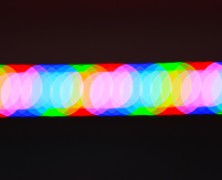With the rise of the smartphone and ubiquitous internet connectivity, retailers have found themselves on the hunt for new ways to interact with their guests. One of the most promising of these is LED-based Visual light Communication (VLC), which gives retailers a powerful in-store tool to engage with customers. The opportunity to harness the power of VLC (also known as Li-Fi) is another great reason for retailers to make the switch to LEDs. LED technology makes VLC possible because of the extremely fast rate at which the chips can be switched from on to off, and vice versa. This rapid fire switching means LED lighting systems can be modulated with computer chips to convey data at such a fast rate that the human eye won’t even perceive a flicker in the constant white light used to light the store. The LED lights communicate with the camera lens of mobile devices. Shoppers in the store will opt in to “listen” to the VLC-based communications, supplying the store with extremely accurate location data similar to GPS, but it works indoors and its accuracy rate is within centimeters. The store could then use the data to provide location-based services or personalized content to shoppers as they browse the aisles. The technology could also be used to serve as a navigation device in airports and museums. Already the Museum of Science in Boston is featuring the first pilot project by ByteLight, a startup that uses LED lighting equipped with chips and software to provide visitor locations and promote interactive learning. The LED system uses VLC to communicate with iPad cameras to create a richer experience, and to provide a fuller breadth of information for the exhibit which pertains to how digital technology is affecting our lives. While traditional technologies such as signs...
What Is Li Fi Technology? LED Lights Connecting Us To The Internet...
posted by Taran Volckhausen
Li fi technology, also known as light fidelity or Visible Light Communication (VLC), uses flickering LED lights to transfer wireless data. If you’re reading this, chances are you’re familiar with Wi-fi and have probably already used it at some point today. Wi-fi is a technology that allows you to use radio waves to connect to the internet. But what if instead of spewing out Wi-fi radio waves throughout your house and apartment, you used highly directed beams of LED light? A Li-fi connection would allow your laptop, smartphone or tablet to connect to the internet via the same lights used to light your room. The LED networks work by flickering light at a rapid fire rate, invisible to the human eye. To connect to a Li-fi network, devices must be equipped with the capability to recognize the LED light signals and use them to transfer data. The term “Li-fi” was coined by Harald Haas at a 2011 TED talk, during which he explained that by using a flickering LED light outfitted with a microchip, data can be transferred to laptops and mobile devices. The advantages of Li-fi over Wi-fi are numerous; they increase network security, don’t emit radiation and speed up connection rates. A multitude of micro-LED bulbs allows streams of light to be beamed in parallel, with each stream multiplying how much data can be carried over the connection. Each bulb is enabled to handle millions of changes in light intensity per second, acting as an extremely fast on and off switch and allowing a high speed transfer of binary data – a series of ones and zeros. “If you think of a shower head separating water out into parallel streams, that’s how we can make light behave,” Professor Harald Haas told the BBC....






